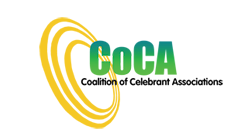In this multi-cultural, secular society, CoCA associations take this statement from the Council of Australian Governments (COAG) 2012 policy objective - the need to provide ‘a productive and highly skilled workforce which contributes to Australia’s economic future, and to enable all working age Australians to develop the skills and qualifications needed to allow them to participate effectively in the labour market.’ Where marriage was once the stable core of our work, the various changes over the last twenty years means that this is no longer the case.
From the statistics we have available to us, we know that civil celebrants marriage work has dropped from an average of 64 weddings per year in 1995, to 35 weddings per year in 1999, to 7 weddings per year in 2012, with a slight rise to 10 or 11 weddings per celebrant per year in 2016. From an economic point of view, this means an average drop in income from around $32000 pa gross (in today's terms) in 1995, to around $6000 pa gross now. This is not ‘participating effectively in the labour market’.
The CoCA associations have post-2003 celebrants calling upon us to advocate for a 5 year moratorium on new appointments and even questioning why the government cannot set a minimum fee for marriage work to stop the price cutting that comes with an oversupply of any product or service. In some areas, it is almost a race to see who can charge the least, and quality service suffers as a result. This is history repeating itself in a way, similar to when the set fee became insufficient to cover costs for those celebrants who provided more than basic marriage services to meet the increasing demand by the public for more complex personalised ceremonies. The intent of the 2003 changes, outlined in the 2002 Explanatory Memorandum, which led to the evolution of the monitoring role of the MLCS was to support the continued development of celebrancy as a profession, not lead to a situation where most celebrants are subsidising their marriage work from other sources.
Our target market of civil weddings is increasingly diverse. Fewer weddings per annum mean more celebrants being confronted with a higher proportion of challenging situations for which they need advice and support. And fewer celebrants with broad experience and expertise they can call upon for that advice and support. Structural and staff changes in the State and territory registry offices mean traditional advice and support from that sector is being diverted to the Commonwealth. BDM staff are not trained in marriage law, yet are advising celebrants on matters outside their scope of marriage registration, causing confusion. As a result of these trends, CoCA predicts increasing demands for MLCS help line support with the potential for a blow-out of costs. One-on-one advice is a high cost and inefficient method of transmitting information.
If the long-term effects of these trends is to increase annual fees, then the concern for celebrants who are members of associations is that they are likely to be subsiding those celebrants who do not join a professional association, who do not keep up to date with changes in legislation and who do not consider marriage work as part of a professional role or labour market activity.
Under Cost Recovery Policy, the Marriage Law and Celebrant Section is required to ensure that it delivers cost efficient and effective services, so that the regulatory burden on celebrants is not increased.
We are stakeholders in the Marriage Act. Changes to the Act affect us directly. Changes to the Act have the potential to directly impact on our ability to participate effectively in the labour market. How can we be included effectively in discussions that are taking place around potential changes that will impact us?
CoCA’s role is to work with government on changes that are being proposed to the Marriage Act and to have direct input to activities/changes that directly affect us in our celebrant role. It is our intent to continue to collaborate with MLCS on changes to the Act and the Commonwealth Marriage Celebrant Program in relation to the marriage work component of the celebrant's work so that the COAG objective “participate effectively in the labour market" can be met. The CoCA National Celebrant Survey is one project we have commenced to gain more information on celebrants views and needs with regard to these workforce issues.
The Australian public need and deserve a properly trained, professional, high standard of service to apply to this most vital social role.
Reminder:
Whether you belong to an association or not, you have been invited to complete this National Celebrant Survey 2016.
This information will help our workforce development planning. v


